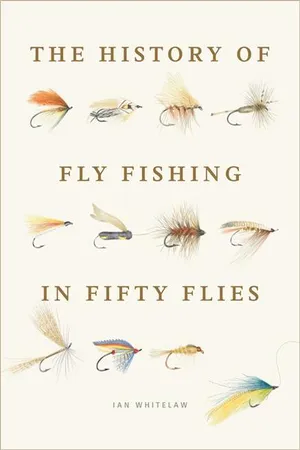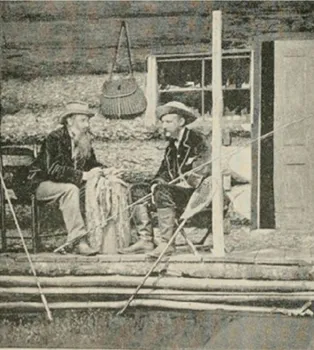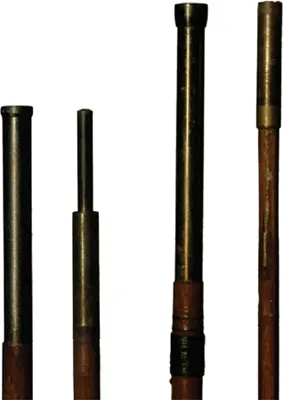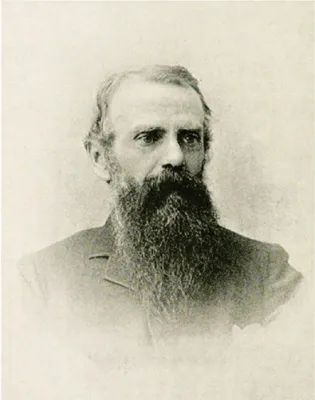![]()
THE STATE OF THE ART IN 1900
Until 1800, the story of the development of fly-fishing tackle as we know it is largely set in the British Isles, and throughout the first half of the 19th century most of the equipment in use in North America was imported. However, by the middle of the century the United States had adopted, adapted and was steadily improving, especially in the important areas of rods and reels, making advances that would later be taken up on the other side of the Atlantic.
Rods
At the start of the 1800s, rods were still being made from hardwoods such as ash, hickory and hazel, with the relatively recent addition of lancewood and greenheart from abroad, and whole Calcutta cane was making inroads as a material for rod tips. Some rods had male/female joints of wood and brass but the joints tended to be heavy and unreliable. Rods and joints gradually improved during the first half of the century, but one particular innovation was gaining ground.
While its lightness and strength made cane suitable for rod tips, it was hard to find knot-free lengths, so in the early 1800s makers began splitting the cane and gluing and binding four “clear” strips together. The resulting rod tip was lighter, stronger and more flexible than whole cane. Hardwood rods with split-cane top sections became common, but it took a while for any British maker to consider making the whole rod this way, and by then America had taken the lead.
Samuel Phillipe of Pennsylvania was building entire rods of four-strip split cane in the 1840s, and the first six-strip split Calcutta cane appeared in the 1850s, the first maker being Charles Murphy of New Jersey or Solon Phillipe, the son of Samuel. Other manufacturers followed suit, and eventually everyone came aaround to the hexagonal profile. At that time each rod section was being hand planed and sanded, tested and corrected, to produce the required power and degree of flexion in the final rod, a very time-consuming process with unpredictable results. The next major step forward was the creation by H.L. Leonard of a planing/beveling machine to produce a consistent and carefully calculated compound taper on every rod. Leonard’s rods were quite simply the best at the time—he produced some 200 rods in 1876—and he literally kept the machine, the heart of his enormously successful business, under lock and key. Others eventually developed similar machines but they had to work out for themselves the secret of his winning taper and it also took a while to discover that Leonard was using a much better kind of cane—Tonkin cane from China.
The frontispiece of Mary Orvis Marbury’s Favorite Flies and Their Histories shows William Cowper Prime and William F. Bridge outside a fishing cabin in the late 1870s. By this time the light and slender split cane rod was rapidly gaining favor.
Salmon rods, up to 17ft (5m) long but now made of greenheart, were no longer spliced but had lighter and more effective ferrules, while trout rods became transformed into shorter, two-piece rods that became all the vogue. This change was strongly influenced by two events in Britain—W.C. Stewart’s exhortation to use a short, stiff, single-handed rod and to use the false cast to dry the line and the fly, and the move to dry fly-fishing championed by such characters as Halford. Leonard’s rods soon found themselves in the hands of the British chalk stream anglers, including G.E.M. Skues, who was fulsome in his praise of the new “weapon.”
“I think the chief part of the ecstasy of fishing with the fly is to be found in the qualities of the fly rod, and if I am right in this, the more exquisite the rod the keener and more perfect the pleasure to be derived from the sport, a strong argument in favour of perfection in one’s weapon for the particular game in hand.” G.E.M. Skues, The Fly-fishers’ Journal, 1917
Reels
In the course of the 19th century a range of manufacturers, responding to the growing popularity of the sport, put some serious effort into reel design, both in Britain and, to an even greater degree, in the USA. The ineffective British multiplier—primarily used for bait casting—was greatly improved by George Snyder and other precision engineers in Kentucky from 1820 onwards, and larger versions for trolling were developed in New York State, but the quality and design of fly reels, too, moved forward in leaps and bounds.
Throughout the 19th century and even into the 20th it was common to have a hardwood butt and middle rod section with a split-cane tip. Ferrule design varied considerably.
These three reels, all with foot mountings, show the variations in style in the second half of the 19th century.
The J.C. Conroy & Co. reel (c. 1871) is made of German silver, the C.F. Orvis plated brass reel (c. 1885), with its lightweight perforated plate that allows the silk line to dry, set the standard for the early 20th century, and the solid Julius Vom Hofe reel (c. 1890) is faced with black rubber.
Fly reels became narrower between the face plates and the diameter of the spools increased to increase the speed of line retrieval, new materials such as aluminium were used, and the old threaded spike fittings gave way first to clamp fittings and then to the plate foot of the modern reel. Rod design incorporated the reel seat to accommodate this. Click mechanisms were introduced to prevent overrun.
On both sides of the Atlantic the number of manufacturers escalated, some mass producing cheap brass reels while others, such as the US companies of Julius Vom Hofe, Pfleuger, Orvis, Leonard and Francis Loomis (who developed an automatic reel) focused on craftsmanship and high quality materials including German silver and hard rubber.
More than 100 years after it was first created, the Hardy Perfect reel—in a far more refined form—is still in production.
Charles F. Orvis opened his tackle shop in Manchester, Vermont, in 1856 and soon established his company—now the oldest mail-order bu...





